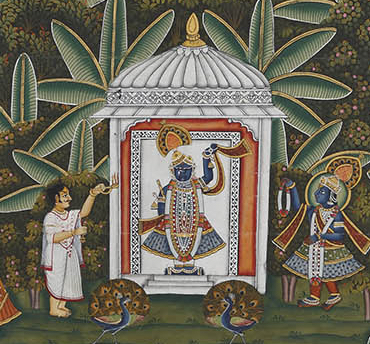During India’s medieval era between 6th and 16th century, the Deccan was a politically complex region with empires big and small colliding with each other in a perpetual battle for supremacy. Their trajectories were guided by charismatic men and women. The most influential rulers introduced policies, formed alliances and founded kingdoms that could weather the storms of the future. You read about their dynasties in Empires of the Deccan – 1,000 years of shifting sands, now let’s meet some of these historic characters.
Loka-Mahadevi of the Chalukyas – Second to none
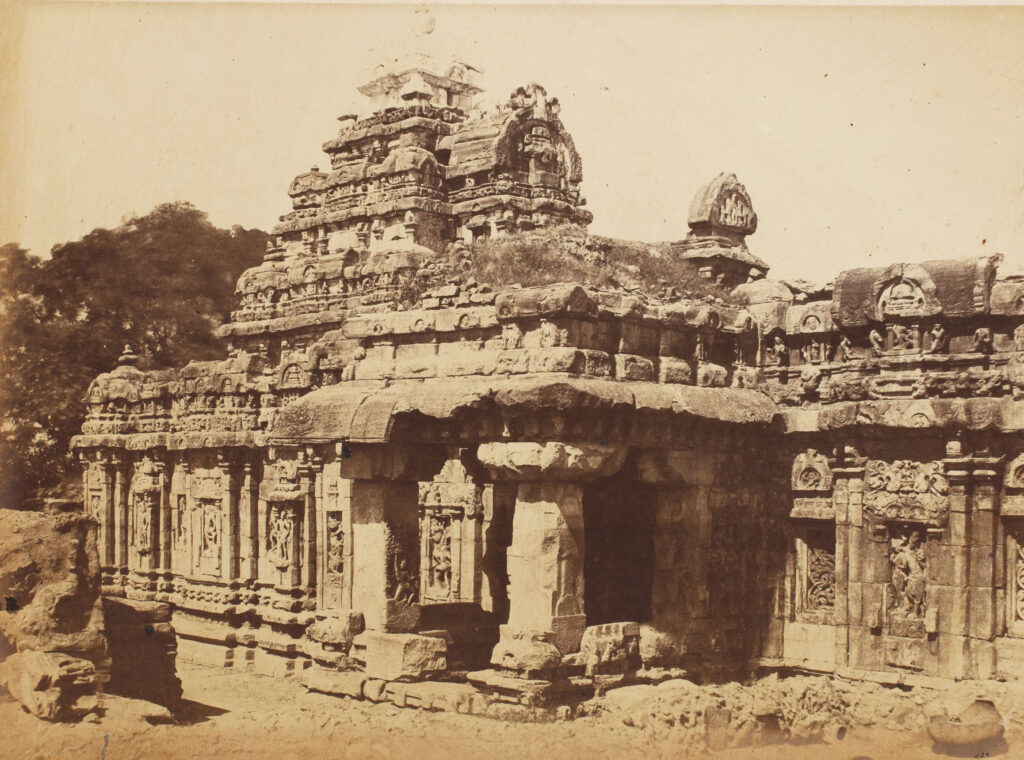
Lokeshwara Temple aka Virupaksha Temple at Pattadakal was commissioned by Lokamahadevi. Photo by Col Thomas Biggs, 1856, image © Sarmaya Arts Foundation
Loka-Mahadevi, a Kalachuri princess who married the Chalukya king Vikramaditya II, was among the most prominent rulers of the early medieval period. She and her younger sister Trailokya-Mahadevi were both married to the king to cement the alliance between the clans. In the early 720s, Trailokya-Mahadevi gave birth to the heir apparent to the Chalukya throne and died soon after. Loka-Mahadevi adopted her sister’s son and became one of the most powerful queens of the Deccan.
The histories of Chalukya and Rashtrakuta dynasties feature women who wielded power and manipulated succession battles, like Danti-durga’s mother Bhavnaga. But Loka-Mahadevi surpassed them all by controlling two Chalukya regions in her own right. When her husband was named crown-prince in the last decade of his father’s reign, c. 720, she presided over court with him. She administered land grants and distributed revenues to villages, without placing a request with the emperor as was customary for royal women at the time. In the early 730s, Loka-Mahadevi as queen commissioned the building of a large temple in Pattadakal. The iconography of the temple’s art hinted at parallels between its patroness and Goddess Prithvi. Named for her, Lokeshwara temple still stands today as a shining example of Chalukya architecture.
Amoghavarsha I of the Rashtrakutas – Royal revolutionary
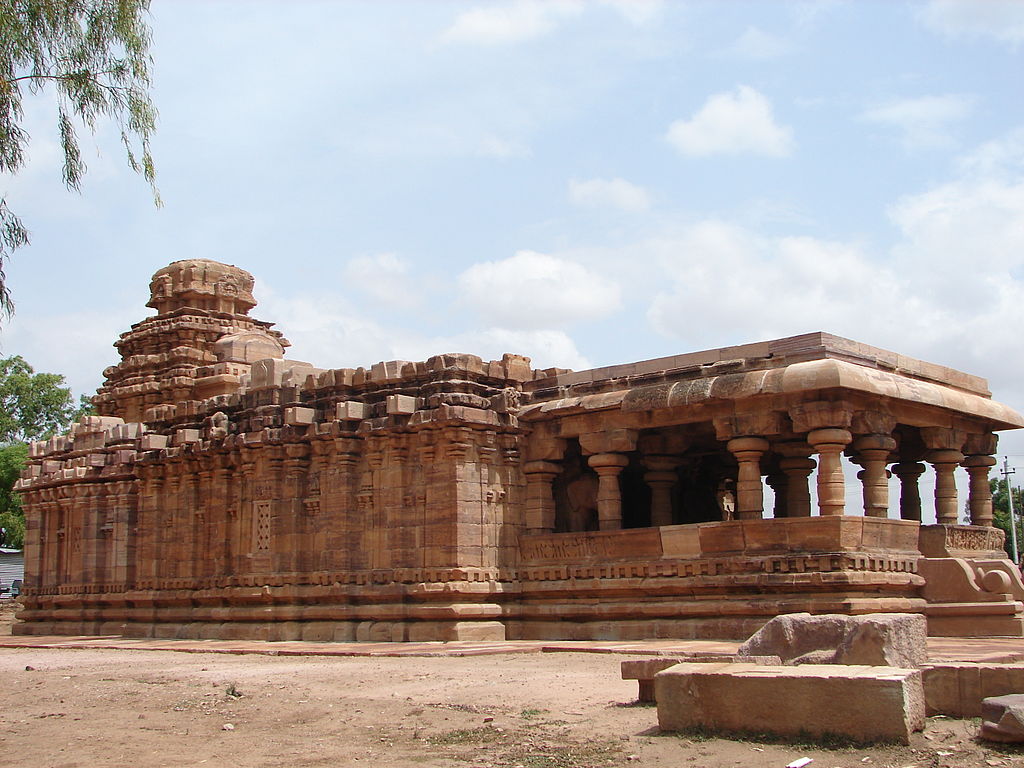
Jaina Narayana temple at Pattadakal is believed to have been commissioned by Amoghavarsha I. Photo by Dinesh Kannambadi/ CC BY-SA 3.0 via Wikimedia Commons
Amoghavarsha I was a towering personality of the early medieval era, known not just for his kingly conquests but also his sizeable contributions to architecture and Kannada literature. He ascended the throne in 815 as a 14-year-old, but was soon ousted by in a revolt by the feudatories of the empire. When he returned to take his rightful place in 821, Amoghavarsha I had matured into an astute diplomat. To appease his feudatories, the Gangas who were great patrons of Jainism, he too began to build important temples and monasteries. The surviving Jain temples and caves of Badami are testaments to the generosity of the king and his successors. Amoghavarsha I took advantage of the Deccan’s western ports and developed steady exports for revenue. This was a marked departure from the economics of his predecessors, who depended on warfare and loot to fund state and military affairs.
The king, a writer and poet himself, observed a chasm between his Sanskrit-speaking courtiers and the Kannada-speaking citizens they governed. He removed Sanskrit as the court language and appointed Srivijaya, the royal poet, to produce a manual on courtly Kannada grammar. According to historian and author of Lords of the Deccan, Anirudh Kanisetti, “This was the first text in the world to ‘self-consciously’ theorise the relationship between a vernacular language and the cosmopolitan Sanskrit.” Amoghavarsha’s decision rippled out to birth a literary revolution across the kingdom and allowed the common man to participate in this cultural phenomenon.
Abul Muzaffar Alauddin Bahman Shah of the Bahmani Sultanate – First of his name
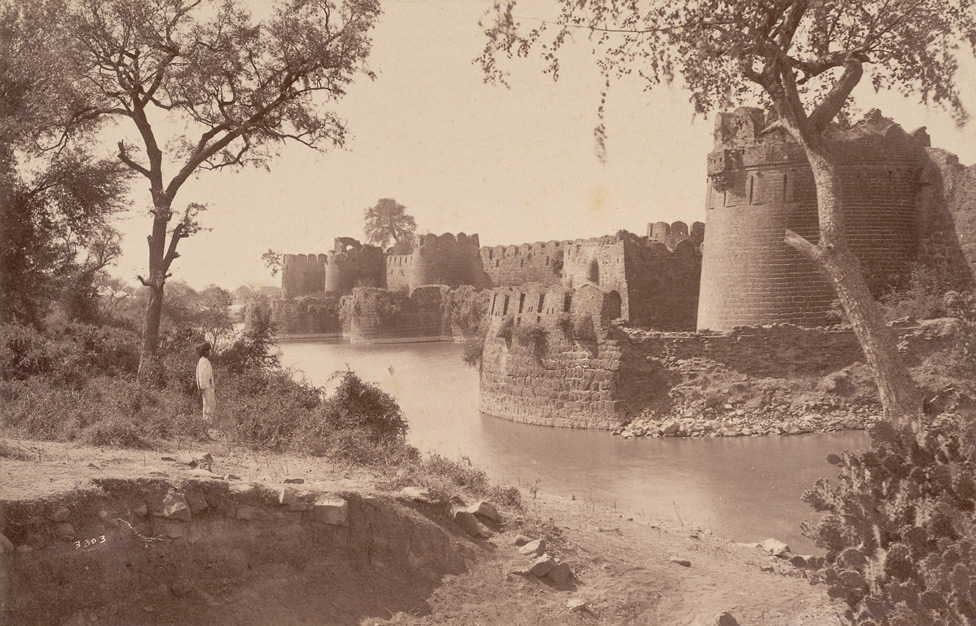
Gulbarga Fort, where Abul Muzaffar Alauddin Bahman Shah established his empire’s seat of power. Photo by Lala Deen Dayal/ Public domain, via Wikimedia Commons
The founder of the Bahmani Sultanate was born with the unlikely name of Hasan Gangu, which has been the cause of much speculation. His birth-name suggested he was part-Muslim and part-Hindu. But the royal title of ‘Bahman’ pointed to Persian origins. Or was it just a result of his having lived for years among Afghans? According to historian Manu S Pillai, the Sultan came from Persian lineage and his uncle served as a courtier for the Khiljis of Delhi. He grew up in Multan, where he too served the Delhi Sultanate till 1339, when he launched a failed rebellion against the Tughlaqs. The exiled warrior returned and six years later, he established his own empire in southern India, the Bahmani Sultanate.
Bahman Shah became the first Muslim ruler in India to discontinue jiziya, the practice of levying tax on non-Muslim citizens. Two centuries later, Mughal Emperor Akbar would famously follow this example. The two Muslim rulers were similar in other ways too. Both took an interest in learning about other religions. In 1352, the Sultan would visit Ellora caves accompanied by a scholar to interpret its frescos and sculptures. Sensitive to the diversity of faiths and cultures in the Deccan, Bahman Shah would, on his deathbed in 1358, advise his sons to stand united to lead the kingdom.
Krishnadevaraya of Vijayanagara – King of the people
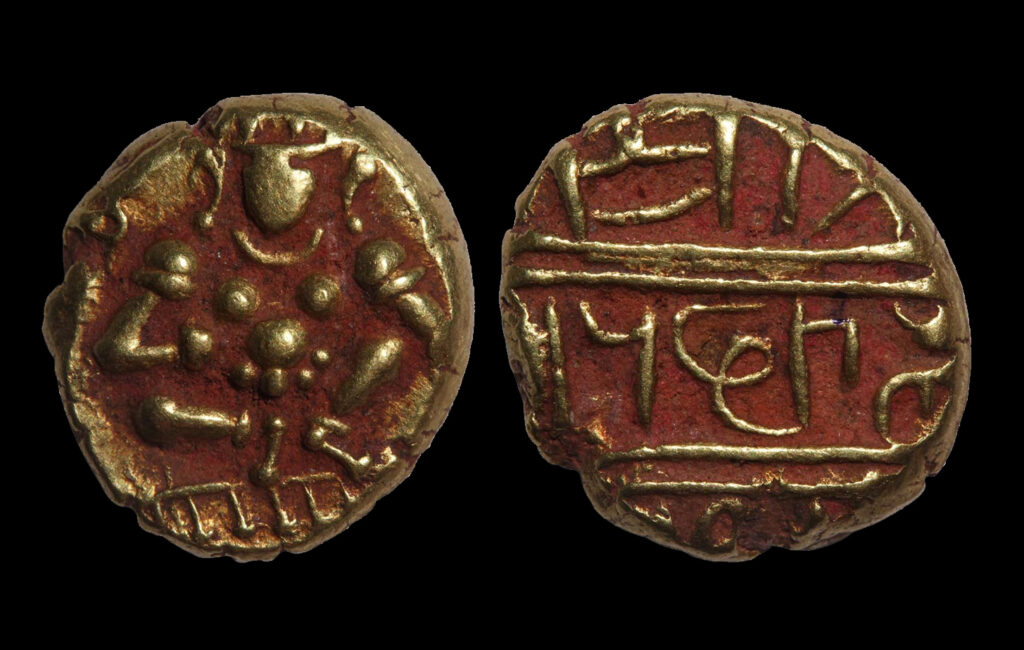
Gold pagoda coin issued by Krishnadevaraya of Vijayanagara, 1509-1529 CE, image © Sarmaya Arts Foundation
Krishnadevaraya, the king responsible for the Vijayanagara’s golden age, was never meant to rule. His mother was considered of inferior birth, and it was his half- brother Viranarasimha who was crowned king. Legend has it that as Viranarasimha lay dying, he asked his ministers to blind Krishnadeva so that his children could succeed the throne. However, at the Virupaksha temple in Hampi in 1509, Krishnadeva stepped towards his destiny and was crowned Raya.
Krishnadevaraya’s early career was marked by conquests over the region of the Raichur Doab, once the seat of power of Harihara, founder of the Vijayanagara empire. He scaled the impregnable Raichur Fort, built by the Kakatiyas 200 years ago, and attacked its thick walls with simple pickaxes and crowbars. Leading a band of swordsmen, he defeated the Bijapur Sultan’s army, which was equipped with the cutting-edge technology of the time—guns. Krishnadevaraya subsequently suppressed local rulers of the Krishna River, raided Bidar, Bijapur and Ahmadnagar and moved into the east coast, defeating the suzerain of Orissa. The expeditions generated considerable revenue for the state.
Apart from his military might, Krishnadevaraya was known as an able administrator who built a strong government, alive to the concerns of its people. It is said that he would have spies wandering his own kingdom, bringing him the latest news. Sometimes, the emperor would take to the streets in disguise to mingle with his subjects and understand the common man’s perspective.
Chand Bibi of the Bijapur Sultanate – Fighter, survivor, leader
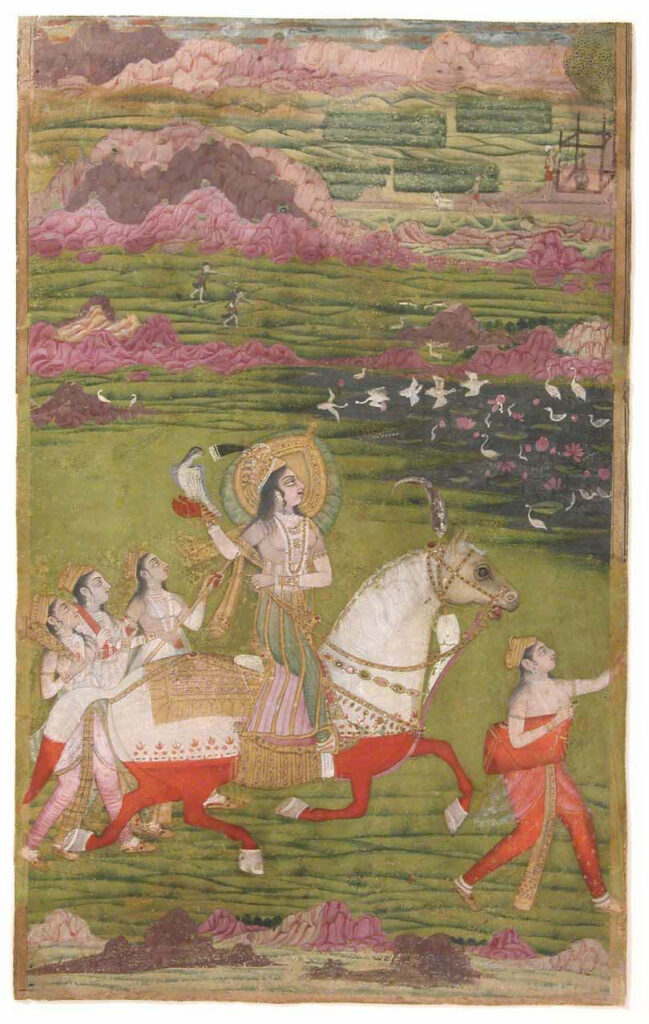
‘Chand Bibi Hawking with Attendants in a Landscape’, c 1700. Image from Metropolitan Museum of Art/ CC0, via Wikimedia Commons
Chand Bibi began her career as a political pawn and ended it as Sultan. Daughter of Sultan Husain Nizam Shah I of Ahmadnagar, she was married to Ali Adil Shah I of Bijapur to fortify an important political alliance. The marriage would seal the bond between the two empires and improve their chances against growing threats from the Vijayanagara rulers. In time, however, Chand Bibi carved out a name for herself in the high-stakes political landscape of 16th-century Deccan.
Whether in court or out on campaigns, Chand Bibi stood shoulder to shoulder with her husband. In 1580, when her husband was assassinated without an heir, she placed a 9-year-old on the throne and ruled as a regent. This victory, however, was short-lived and she was ousted and thrown in prison.
She then turned towards her homeland, Ahmadnagar, where succession battles were in full swing. Her brother sought the help of the Mughals to rise to the throne, but refused to recognise their suzerainty after his accession. This brought the Mughal armies to Ahmadnagar in 1595. With the Sultan already dead, Chand Bibi marched with her fellow countrymen to protect the kingdom. A truce was reached, she received the title of Chand Sultan and finally, she ruled an empire in her own name. Chand Bibi became a popular subject of Deccani and Mughal paintings, often depicted in the sport of ‘hawking’. Hunting with hawks was considered a man’s sport, so the iconography speaks volumes for the fierceness and authority of this Deccan queen.
References
- Kanisetti, Anirudh Lords of the Deccan: Sothern India from the Chalukyas to the Cholas, Juggernaut, New Delhi, 2022 Pg 252-267; 360-417
- Pillai, Manu S. Rebel Sultans: The Deccan from the Khilji to Shivaji, Juggernaut, New Delhi 2018; pg 35-107
- Pillai, Manu S. Chand Bibi: The Warrior queen of the Deccan, MintLounge, India, 2019
- Stewart, Courtney A. Feminine Power of the Deccan: Chand Bibi and Mah Laqa Bai Chanda, 2015



